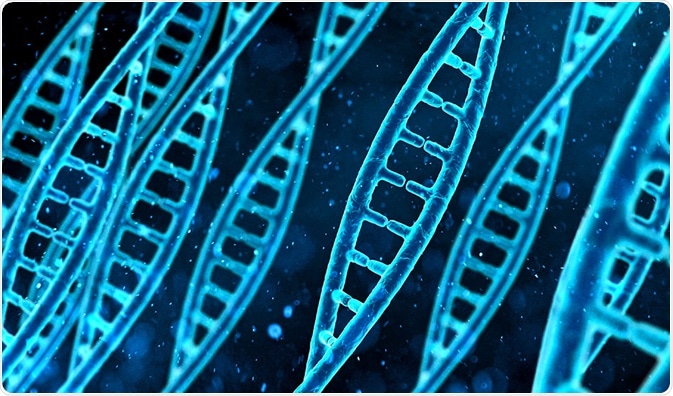By Jeyashree Sundaram, MBA
Schizosaccharomyces pombe is an ascomycete yeast which replicates through binary fission. It is a model organism for studying mitosis in eukaryotes and has been used extensively in the field of genetics.

Credit: SynthEx/Shutterstock.com
S. pombe is a rod-shaped unicellular archiascomycete fungus that has several characteristics in common with cells of other complex eukaryotic organisms. This makes it a model organism for the study of cellular and molecular biology in eukaryotes.
In 1946, geneticist Urs Leupold began the study of S. pombe. Following on from his work, researchers isolated various mutants and created chromosomal maps of S. pombe. The organism soon became a genetically tractable species for use as a model species.
Since then, researchers have detected 50 genes of S.pombe that are associated with diseases such as diabetes, hereditary deafness, and cystic fibrosis.
Cdc2 and Wee1 in S. pombe
S. pombe can be segregated into two groups of mutants; Cdc and wee, which were identified using recombination and complementation experiments.
Temperature sensitive S. pombe mutants carry recessive mutations in their genome. These mutations inhibit mitotic exit, causing mutants to appear larger than normal cells.
Dominant mutations in Cdc2 genes produce the wee phenotype. Generally, lack of the function of a wildlife protein results in a recessive phenotype, while increased function of the protein results in dominant phenotype due to lack of regulation or overproduction.
Experiments where mutants were isolated showed that a lack of Cdc2 activity inhibits the entry of the cell into mitosis for cell division, whereas increased activity promotes premature mitotic exit.
This creates mutant cells that are larger and smaller than wild-type cells, respectively. These observations confirmed Cdc2 as an important regulator of mitosis in S. pombe.
The discovery of a Cdc2 protein kinase from S.pombe was the main reasoon researchers began to analyze the maturation-promoting factor (MPF) from Xenopus eggs for protein kinase activity. It was later discovered that MPF consists of a protein kinase which is activated by Cyclin B during mitosis and is homologous to Cdc2 in S. pombe.
In addition, MPF was found to react with an antibody against Cdc2, as it contains a region that is greatly preserved among the yeast Cdc2 protein and humans. However, the size of the Xenopus MPF subunit is not as same as Cdc2.
Sequencing and isolation of the cdc13+ gene in fission yeast showed it was also essential to mitosis. Cdc13 encodes a protein that is homologous to Xenopus and sea urchin cyclin B. Like Xenopus MPF, studies reveal heterodimers of Cdc2 and Cdc13 of S.pombe MPF to be protein kinases.
Regulation of MPF kinase
Studies of other wee and cdc genes in S. pombe showed that the activity of MPF (Cdc2-Cdc13 heterodimer) is regulated by proteins encoded by other genes. The results of these studies showed that the Wee1 protein inhibits the activity of MPF in S.pombe, while Cdc25 triggers MPF activity.
Further studies revealed that isolation and sequencing of wildtype wee1+ and cdc25+ genes can be used as expression vectors.
Biochemical studies of the sequences of genes encoding Wee1 and Cdc25 indicated that they control the MPF activity through phosphorylation and de-phosphorylation of specific regulatory domains in the catalytic subunit of Cdc2.
In S. pombe and Xenopus species, MPF is homologous to human cyclin A-CDK2.
Structural analyses of these proteins show that human CDK2 activates cyclin A by phosphorylating threonine-161. This causes a conformational change, allowing protein substrates to bind with high affinity.
Other regulatory mechanisms involved in mitosis
The complexity involved in controlling MPF activity was uncovered by further research of S. pombe mutants with modified cell cycles. Following its inhibition of MPF, wee1 is inhibited by a protein kinase encoded by the nim1+ gene.
Wee1 competes for Cdc2 with other protein kinase encoded by mik1+ gene, which can phosphorylate thyrosine-15 of Cdc2. Various other genes have also been studied that manipulate MPF activity. Therefore, it is understood that several mechanisms control S.pombe MPF activity to regulate the time spent in mitosis and thus the daughter cell sizes.
Further studies revealed Xenopus egg equivalents of S. pombe Cdc25 and Wee1. During interphase, the tyrosine kinase activity of Xenopus Wee1 is high, while the activity of Cdc25 phosphatase is low, ensuring cyclin B remains in the cytosol with the phosphorylation of Cdc2 Tyr-15 and the Xenopus Cdc2 MPF in the inactive state.
As the Xenopus egg extract begins mitosis, the activity of the Wee1 and Cdc25 genes decreases and increases, respectively, in order to convert MPF into active form. Thus, synthesis of cyclin B is essential for early embryonic cycles of Xenopus.
Xenopus Cdc25 and Wee1 activities must be regulated for the cell cycle to occur. One or more protein phosphatases and kinases are involved in controlling Cdc25 activity. In addition, the activity of MPF can be controlled by transcriptional regulation of its associated gene.
Further Reading